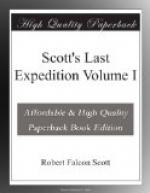The wind fell within an hour almost as suddenly as it had arisen; the temperature followed, only a little more gradually. One may well wonder how such a phenomenon is possible. In the middle of a period of placid calm and out of a clear sky there suddenly rushed upon one this volume of comparatively warm air; it has come and gone like the whirlwind.
Whence comes it and whither goeth?
Went round the bergs after lunch on ski—splendid surface and quite a good light.
We are now getting good records with the tide gauge after a great deal of trouble. Day has given much of his time to the matter, and after a good deal of discussion has pretty well mastered the principles. We brought a self-recording instrument from New Zealand, but this was passed over to Campbell. It has not been an easy matter to manufacture one for our own use. The wire from the bottom weight is led through a tube filled with paraffin as in Discovery days, and kept tight by a counter weight after passage through a block on a stanchion rising 6 feet above the floe.
In his first instrument Day arranged for this wire to pass around a pulley, the revolution of which actuated the pen of the recording drum. This should have been successful but for the difficulty of making good mechanical connection between the recorder and the pulley. Backlash caused an unreliable record, and this arrangement had to be abandoned. The motion of the wire was then made to actuate the recorder through a hinged lever, and this arrangement holds, but days and even weeks have been lost in grappling the difficulties of adjustment between the limits of the tide and those of the recording drum; then when all seemed well we found that the floe was not rising uniformly with the water. It is hung up by the beach ice. When we were considering the question of removing the whole apparatus to a more distant point, a fresh crack appeared between it and the shore, and on this ‘hinge’ the floe seems to be moving more freely.
Friday, June 30, 1911.—The temperature is steadily falling; we are descending the scale of negative thirties and to-day reached its limit, -39 deg.. Day has manufactured a current vane, a simple arrangement: up to the present he has used this near the Cape. There is little doubt, however, that the water movement is erratic and irregular inside the islands, and I have been anxious to get observations which will indicate the movement in the ‘Strait.’ I went with him to-day to find a crack which I thought must run to the north from Inaccessible Island. We discovered it about 2 to 2 1/2 miles out and found it to be an ideal place for such work, a fracture in the ice sheet which is constantly opening and therefore always edged with thin ice. Have told Day that I think a bottle weighted so as to give it a small negative buoyancy, and attached to a fine line, should give as good results as his vane and would be much handier. He now proposes to go one better and put an electric light in the bottle.




